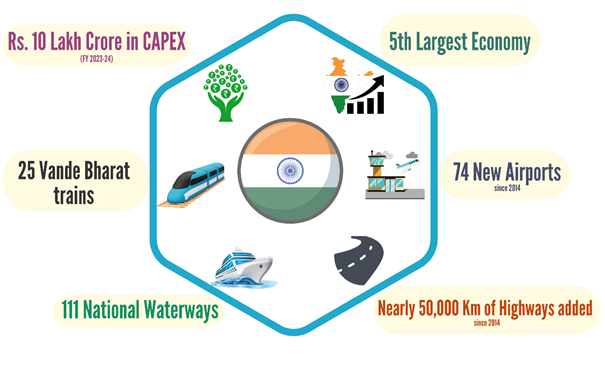Ministry of Information & Broadcasting
India's Infrastructure Revolution
Posted On: 10 JUL 2023 2:23PM
PAVING THE WAY FOR ECONOMIC GROWTH
India is experiencing a blitzkrieg upgrade in its infrastructure, driven by increased government investment and development initiatives. There are significant advancements in India's transportation networks, including roads, railways, aviation, and waterways, and their impact on the country's economic growth. These infrastructure developments aim to enhance connectivity, reduce logistics costs, and position India as a global economic powerhouse. Fuelled by the ambitious PM Gatishakti National Masterplan for multi-modal infrastructure development, the new roads and railways will help India fulfil its ambition to turn into a $5 trillion economy—up from $3.74 trillion currently (IMF, 2023).

Revitalizing Road Networks
India boasts of the world's second-largest road network, with over 6.37 million kilometres. In recent years, there has been a substantial increase in the pace of construction of national highways, from an average of 12 kilometres per day in 2014-15 to around 29 kilometres per day in 2021-22. The total length of highways has expanded from 97,830 kilometres in 2014 to 145,155 kilometres today. Moreover, in the last nine years, more than 3.5 lakh kilometres of rural roads have been constructed under the Pradhan Mantri Gram Sadak Yojana giving all-weather roads connectivity to villages of India. The government's budget support for road infrastructure has rapidly increased, reaching approximately ₹1.4 lakh crore in FY22-23. Completion of strategic projects like the Atal Tunnel, the Dhola-Sadiya Bridge, and the Chenab River Bridge, some of which had been pending for years, on a war footing is a testament to the government’s inclusive governance and its commitment to connectivity even in the remotest and difficult terrains of the country.
Revolutionizing Railways
India's railways have undergone substantial modernization and expansion. Capital expenditure on railway infrastructure has steadily increased over the past four years, with a budget of ₹2.5 lakh crore allocated in FY22-23, representing a 29% rise compared to the previous year. Electrification of railway tracks has witnessed significant progress, reaching 37,011 route kilometres in the last nine years. Further, on 4 March 2022, the successful trial of KAVACH, a state-of-the-art electronic system designed to help the Indian Railways achieve Zero Accidents was conducted. The introduction of the indigenously designed Vande Bharat Express, which are already functional in 25 routes, and its subsequent expansion showcases India's commitment to high-speed rail travel. The ongoing construction of a high-speed line between Mumbai and Ahmedabad, with Japanese collaboration, and the development of new freight corridors will further boost connectivity, reduce travel time, and facilitate the efficient movement of goods and passengers.
Aviation Sector's UDAN
India's aviation sector has experienced substantial growth, positioning the country as the world's third-largest market. To promote regional connectivity and revive unserved or underserved airports, the government has allocated a budget of ₹4,500 crores under the Ude Desh ka Aam Nagarik (UDAN) scheme. The number of airports with civilian flights has doubled in the last nine years, from 74 in 2014 to 148 in 2023. Additionally, the government has also accorded 'in-principle' approval for setting up 21 greenfield airports across the country. Further, the upcoming greenfield Noida International Airport will also be the country's largest centre for aircraft maintenance, repair and operation (MRO), bolstering the aviation sector and generating employment opportunities.
Harnessing Waterways
India recognizes the immense potential of its waterways in establishing a sustainable logistics sector. The government's focus on inland water transport has led to the declaration of 111 National Waterways. The cargo movement on these waterways reached a record high of 108.8 million tons in FY22, reflecting a growth of 30.1% compared to the previous year. The Inland Vessels Bill 2021 further facilitates the growth of inland water transport, creating a robust multi-modal transport ecosystem and fostering ease of doing business. Additionally, the Sagarmala Project aims to develop ports, streamline compliances, and reduce vessel turnaround time.
Economic Implications and the Future
Transport infrastructure development reduces transport costs, increases gains from trade, and drives up wages, thus boosting economic activity. The development of infrastructure has helped move workers from agriculture to more productive jobs. Making this transition possible and feasible, also inspired improvements in educational attainment in villages.
India will be integrated into a high-quality transport network, powered by greenfield expressways, electrified railways, revamped airports, and an EV ecosystem. The transformative power of new infrastructure is a precondition for the high growth that India aspires to achieve. It is a rising tide that will lift all the sections of India.
According to a recent report by American Investment Bank Morgan Stanley, India has transformed itself in less than a decade due to key policy choices like supply-side reforms, formalization of the economy, real estate regulation, digitizing social transfers, insolvency and bankruptcy reforms, flexible inflation targeting, focus on FDI, reforms in equity markets and government support for corporate profits among other measures.
The report suggests that in the coming decade, there is going to be a steady increase in many macroeconomic indicators of the Indian economy. India’s manufacturing capacity is expected to reach USD 1500 billion by 2032 as compared to USD 447 Billion in 2022; export market share to more than double to 4.5% by 2031 as compared to 2.2% in 2021; and India’s per capita income is expected to more than double from USD 2,200 currently to about USD 5,200 by 2032. The report concludes that India will emerge as a key driver of global growth with New India driving a fifth of the global growth through the end of the decade.
*Authors: Nimish Rustagi, Additional Director General; Himanshu Pathak, Deputy Director; and Pinak Pani Datta, Young Professional, Research Unit, Press Information Bureau.
NR/HP/RK/PPD
(Features ID: 151518)
0